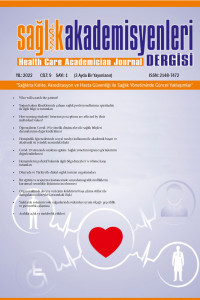Öz
Kaynakça
- Yabacı, S., Akça, N. K., & Arslan, D. E. (2019). Kaşıntı-Stres Kısır Döngüsü ve Hemşirelik Yaklaşımı. ERÜ Sağlık Bilimleri Fakültesi Dergisi, 6(2), 26-34.
- Verduzco, H. A. & Shirazian, S. (2020). CKD-associated pruritus: New insights into diagnosis, pathogenesis, and management. Kidney International Reports, 5(9), 1387-1402. DOI:10.1016/j.ekir.2020.04.027
- Hashimoto, T. & Yosipovitch, G. (2019). Itching as a systemic disease. The Journal of Allergy and Clinical Immunology, 144(2), 375-80. DOI:10.1016/j.jaci.2019.04.005.
- Andrade, A., Kuah, C. Y., Martin‐Lopez, J. E., Chua, S., Shpadaruk, V., Sanclemente, G., & Franco, J. V. (2020). Interventions for chronic pruritus of unknown origin. Cochrane Database of Systematic Reviews, 1, 0130128. DOI:10.1002/14651858.CD013128.
Öz
The urge to scratch is one of the basic needs of individuals in daily life. Itching sensation occurs as a result of the activity of special nerve cells in the epidermis and dermal-epidermal junction points. Although the methods reduce the itching of the patient, in some cases itching may occur due to psychological or undetected allergens, and it may be necessary to satisfy the itching sensation by maintaining the skin integrity of the patient. It is clear that patients who cannot take care of themselves, who are bedridden, who are sedated, and who receive intensive care treatment will have difficulty meeting even their ordinary daily scratching needs. Especially intensive care patients are hesitant to act due to pain, fear, monitoring, and the presence of many medical tools and equipment on them. For this reason, it may be recommended to realize the needs of patients who have difficulty in scratching themselves and to make plans for eliminating the need for scratching in patient care.
Anahtar Kelimeler
Kaynakça
- Yabacı, S., Akça, N. K., & Arslan, D. E. (2019). Kaşıntı-Stres Kısır Döngüsü ve Hemşirelik Yaklaşımı. ERÜ Sağlık Bilimleri Fakültesi Dergisi, 6(2), 26-34.
- Verduzco, H. A. & Shirazian, S. (2020). CKD-associated pruritus: New insights into diagnosis, pathogenesis, and management. Kidney International Reports, 5(9), 1387-1402. DOI:10.1016/j.ekir.2020.04.027
- Hashimoto, T. & Yosipovitch, G. (2019). Itching as a systemic disease. The Journal of Allergy and Clinical Immunology, 144(2), 375-80. DOI:10.1016/j.jaci.2019.04.005.
- Andrade, A., Kuah, C. Y., Martin‐Lopez, J. E., Chua, S., Shpadaruk, V., Sanclemente, G., & Franco, J. V. (2020). Interventions for chronic pruritus of unknown origin. Cochrane Database of Systematic Reviews, 1, 0130128. DOI:10.1002/14651858.CD013128.
Ayrıntılar
| Birincil Dil | İngilizce |
|---|---|
| Konular | Sağlık Kurumları Yönetimi |
| Bölüm | Editöre Mektup |
| Yazarlar | |
| Yayımlanma Tarihi | 1 Mart 2022 |
| Kabul Tarihi | 2 Ocak 2022 |
| Yayımlandığı Sayı | Yıl 2022 Cilt: 9 Sayı: 1 |



